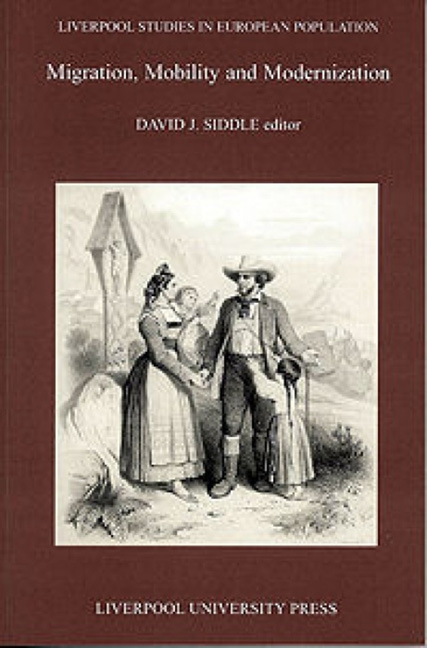Book contents
- Frontmatter
- Contents
- List of Figures
- List of Tables
- 1 Introduction
- 2 Nephews, Dowries, Sons and Mothers: the Geography of Farm and Marital Transactions in Eastern Ireland, c. 1820–c.1970
- 3 Mobility, Kinship and Commerce in the Alps, 1500–1800
- 4 People from the Pits: the Origins of Colliers in Eighteenth-Century South-West Lancashire
- 5 Motives to Move: Reconstructing Individual Migration Histories in early Eighteenth-Century Liverpool
- 6 Urban Population and Female Labour: the Fortunes of Women Workers in Rheims before the Industrial Revolution
- 7 Mobility Among Women in Nineteenth-Century Dublin
- 8 Tramping Artisans in Nineteenth-Century Vienna
- 9 Migration and Urbanization in North-West England: a Reassessment of the Role of Towns in the Migration Process
- Index
2 - Nephews, Dowries, Sons and Mothers: the Geography of Farm and Marital Transactions in Eastern Ireland, c. 1820–c.1970
- Frontmatter
- Contents
- List of Figures
- List of Tables
- 1 Introduction
- 2 Nephews, Dowries, Sons and Mothers: the Geography of Farm and Marital Transactions in Eastern Ireland, c. 1820–c.1970
- 3 Mobility, Kinship and Commerce in the Alps, 1500–1800
- 4 People from the Pits: the Origins of Colliers in Eighteenth-Century South-West Lancashire
- 5 Motives to Move: Reconstructing Individual Migration Histories in early Eighteenth-Century Liverpool
- 6 Urban Population and Female Labour: the Fortunes of Women Workers in Rheims before the Industrial Revolution
- 7 Mobility Among Women in Nineteenth-Century Dublin
- 8 Tramping Artisans in Nineteenth-Century Vienna
- 9 Migration and Urbanization in North-West England: a Reassessment of the Role of Towns in the Migration Process
- Index
Summary
Much of the literature on family farming in Ireland has been concentrated on the small farm culture of the west. This study focuses on the bigger farming world of the east and south-east. It also takes a long time perspective which stretches from the beginning of the nineteenth century almost to the close of the twentieth. Ireland's population in 1800 was five million – the same as today – but three-and-a-half million people fewer than existed on this island in 1845. This study also engages both a period when landlordism was still a dominant force in Ireland (i.e. up to c.1900) and an era when farming proprietorship subsequently became universal. It also straddles one of the most traumatic events in Irish history – the Great Famine of 1845–51 – when one million excess deaths occurred and over one million emigrants/refugees fled the country.
Pre-Famine Ireland was characterized by a ramshackle property structure dominated by landlords and a great variety of leaseholders. Close on thirty per cent of total agricultural output was used to pay rents (Mokyr, 1983, pp. 81–102). One-third of all tenant farmers occupied holdings greater than 20 acres (12 ha). These bigger farmers were dominant in the most profitable eastern and south-eastern regions of the country. However, labourers, cottiers and small-holder farmers then made up a population of four million, or close on half the total population in 1841. These groups were to be found everywhere on the island but the greatest concentrations were in the north-west, west and south-west. Not surprisingly, the Great Famine wreaked havoc amongst these classes.
While recognizing these diverse regional experiences, the Great Famine generally left behind a denuded and simplified rural landscape and a rapidly reducing and restructured society. Extreme caution in property transfers made for late marriage or no marriage, thus helping to mark out Ireland as a demographic exception in the western world. The other side of this property equation was emigration. Up until 1846, emigration was generally seen by most local communities as a social evil. Yet, by 1855, two million people had fled the country.
- Type
- Chapter
- Information
- Migration, Mobility and Modernization , pp. 9 - 46Publisher: Liverpool University PressPrint publication year: 2000



